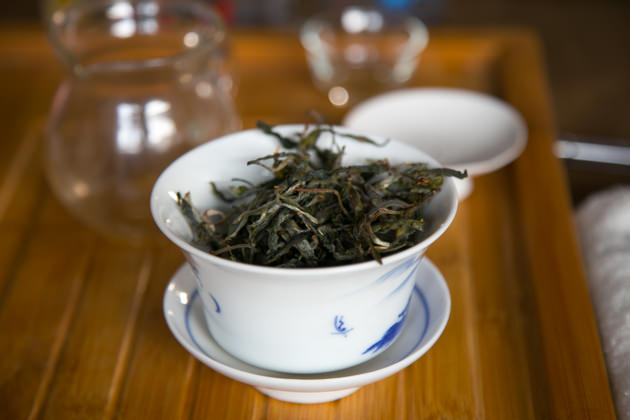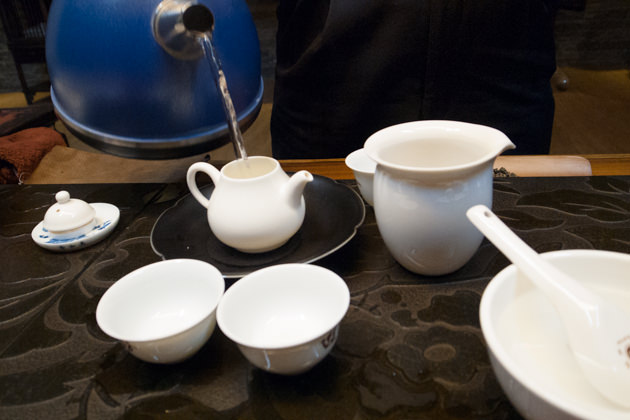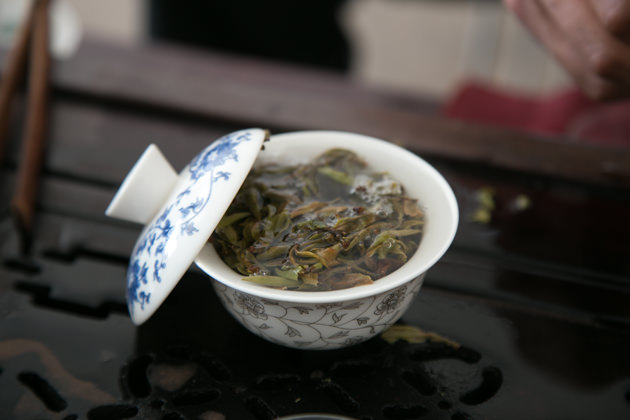- HOME >
- How to enjoy tea
Why do we rinse tea leaf?
- [2015.11.22] Posted By Akira Hojo

We often rinse tea leaf before we brew it. Do you really know the reason for it?
Some people say it is because Chinese tea is often contaminated by pesticide and the rinsing is cleansing process to get rid of it. Of course it is not true. If pesticide is used, it is applied in late spring or summer when weather becomes warmer and pests become an issue. The farmer will not apply pesticide on freshly geminated leaf in spring. The pesticide applied in late spring or summer is absorbed by tea through its root and it stays inside the cell. Technically, there is no way to remove pesticide by rinsing even if it is really used. So what actually is the reason to rinse tea?
3 reasons for rinsing tea leaf
From my point of view, there are three reasons why we rinse tea.
- To unfurl the tea leaf
- Maintain high brewing temperature
- For short time brewing
1. Open tea leaf
Some oolong teas, such as Taiwan oolong and Anxi oolong like Tie Guan Yin, are tightly rolled into ball shape. While Pu-erh tea is often compressed very hard into disc or brick shape. If we brew these teas without rinsing, water may not penetrate inside but only moisten the surface. This will result in very inconsistent brewing.

With rinsing once or twice, these teas will be loosen and unrolled. Usually, the better the quality, the faster the unrolling speed. We need to adjust the rinsing time according to the quality of tea.
2. Maintain high brewing temperature
The flavor and taste of fermented tea such as oolong and black tea are composed of substances like terpene and conjugated poly phenol. These substances are produced as a result of enzymatic oxidation. These substances have lesser affinity than poly phenol exists in non-fermented tea like green tea. Hence, it is important to get higher temperature to efficiently extract the substances when brewing fermented tea.

Many people would think that the temperature of boiling water is at 100 degree C. However, if we measure the actual temperature of hot water right after we stop heating, it is at about 95 degree C. Once it is poured into teapot, the hot water temperature drops about 10 degree C in summer and nearly 20 degree C in winter. In addition, dry tea leaf also contributes in cooling the water temperature to another 10 degree C. If no rinsing is carried out, you are actually brewing tea at 65 or 75 degree C. This is not hot enough at all to bring out the flavor and taste of fermented tea. Therefore, it is very important to warm up teapot with boiling water for 10 seconds, and again rinse tea leaf with boiling water for a few seconds. Usually, it is not very common to rinse black tea. However, some people rinse it if they practice Gong Fu brewing technique.
3. For short time brewing
The naturally farmed tea contains a lot of poly phenol or its oxide. Also as I mentioned above, the main taste component of fermented tea is also poly phenol oxide. In order to brewing these teas well, the key is how to extract these substances. Since these substances have lesser affinity with water, it is important to use water at higher temperature.

However, tea may be damaged if water temperature is too high. To minimize the damage, we ought to practice “high temperature and short time” brewing technique. It is said that high temperature and short time brewing gives lesser damage compared to lower temperature and long time brewing.
In order to achieve high temperature and short time brewing, we need some preparation. Firstly, warm up the teapot with boiling hot water for about 10 seconds. After pour in the tealeaf, rinse tealeaf once or twice swiftly, tealeaf will then unrolled and easier to extract its flavor and taste. Usually, after rinsing I put the lid back on and leave the tealeaf for about 10 seconds. The hot steam will remain inside the teapot. This steaming further helps tea leaf to be ready for subsequent brewing. With this method, we can get sufficient flavor and taste even if we keep entire brewing time in less than a few seconds. We can also practice the same technique for green or black tea. But the rinsing must be carried out as quickly as we can.
Related Articles
How to get the latest update on HOJO?
1. Follow Twitter, 2. Click "Like" on Facebook, and 3. Subscribe in newsletter. You can have the latest tea news from HOJO.
 Subscribe the Newsletter to enjoy the privileges
Subscribe the Newsletter to enjoy the privileges- You may receive a free sample upon purchase, or you may have the priority to purchase special products. So please remember to subscribe our newsletter as well as the social network.
- Myanmar White Tea Bud 2013 from Guo Gan, Myanmar
- We have released a raw Pu-erh tea, 緬甸白芽茶 2013 (Myanmar White Tea Bud 2013), produced by ethnic minorities in t …
- Yong De Wild White Tea 2025 Loose Leaf Limited Release
- We have released Yong De Wild White Tea Loose 2025. For the 2025 harvest, only the loose-leaf type was …
NEW ARTICLES
 Myanmar White Tea Bud 2013 from Guo Gan, Myanmar
Myanmar White Tea Bud 2013 from Guo Gan, Myanmar- We have released a raw Pu-erh tea, 緬甸白芽茶 2013 (Myanmar White Tea Bud 2013), produced by ethnic minorities in t …
 Yong De Wild White Tea 2025 Loose Leaf Limited Release
Yong De Wild White Tea 2025 Loose Leaf Limited Release- We have released Yong De Wild White Tea Loose 2025. For the 2025 harvest, only the loose-leaf type was …
 Experience the True Freshness of Raw Pu-erh : Tang Jia 2025 Loose Leaf Release
Experience the True Freshness of Raw Pu-erh : Tang Jia 2025 Loose Leaf Release- We have released Tang Jia Raw Pu-erh Tea 唐家古樹生茶 2025 Loose Leaf. Among HOJO’s raw pu-erh teas, Tang Jia Raw Pu …
 Yunnan Chun Jian Green Tea from High Mountain Gardens
Yunnan Chun Jian Green Tea from High Mountain Gardens- Yunnan Chun Jian Green Tea is now available. This tea is made from naturally grown leaves harvested from high …
 Limited Loose Leaf Release of 2025 Da Xue Shan Wild Raw Pu-erh Tea
Limited Loose Leaf Release of 2025 Da Xue Shan Wild Raw Pu-erh Tea- We have released the 2025 loose-leaf version of Da Xue Shan Wild Raw Pu-erh Tea. This tea comes from wild tea …
 Discover a New Way to Enjoy Tea: Cooking Rice with Tea
Discover a New Way to Enjoy Tea: Cooking Rice with Tea- Cooking rice with tea is a simple idea, but it brings surprisingly satisfying results. The tea’s flavour seeps …
 2025 Da Xue Shan Wild White Tea Now Available from Yunnan
2025 Da Xue Shan Wild White Tea Now Available from Yunnan- The 2025 harvest of Da Xue Shan Wild White Tea is now available. Crafted from truly wild Camellia taliensis tr …
 Fresh 2025 Yunnan White Tea – Select Your Favourite Lot Before Blending
Fresh 2025 Yunnan White Tea – Select Your Favourite Lot Before Blending- Freshly crafted in Yunnan and just arrived in KL, our new 2025 white tea is now available at our Gardens Mall …
 2024 Dong Shan Raw Pu-erh Tea – Crafted with the Producer for Desired Quality
2024 Dong Shan Raw Pu-erh Tea – Crafted with the Producer for Desired Quality- We have released the 2024 cake of Dong Shan Raw Pu-erh Tea. Earlier, we offered the loose-leaf version from th …
 Development of Firewood Roasted Hojicha Using Naturally Grown Tea from Yunnan
Development of Firewood Roasted Hojicha Using Naturally Grown Tea from Yunnan- We are currently staying in Yunnan Province for tea production. As the season nears its end, tea trees with pa …
Category
- New Arrival at HOJO Online Shop
- Featured Articles
- Newsletter
- Types of Tea
- Origin of Tea
- Teapot and Tea Equipment
- Tea Column
- How to enjoy tea
- Tea Processing
- How to choose quality tea
- Tea constituents and functional effect
- Safety of Tea
- Foods
- Tea Business Operation
- Hobby and Outdoor Activity
- Ranking of Tea
- Video
- FAQ
- Media Release
Profile

- AKIRA HOJO
- I invite you to experience my tea selections.I was born in Nagano, Japan. In university, I studied agricultural chemistry, and I have the master degree in food science. I worked in Japanese food industry for 10 years. I involved in R&D, QC and QA. As a factory manager, I implemented ISO9000 series and managed the factory.
- The Art of Tea Magazine
- We posted the article on “The Art of Tea Magazine No.9, the magazine is published in Taiwan. We featured …
- New Straits Times
- The Malaysian National Newspaper, New Straits Times featured HOJO Tea on 17-Oct-2007.
Shop Info

Address:Lot No. T-215, 3rd Floor, The Gardens Mall, Mid Valley City, Lingkaran Syed Putra, 59200 Kuala Lumpur
Tel: +603-2287-4537
Business Hour: 10am to 10pm

















